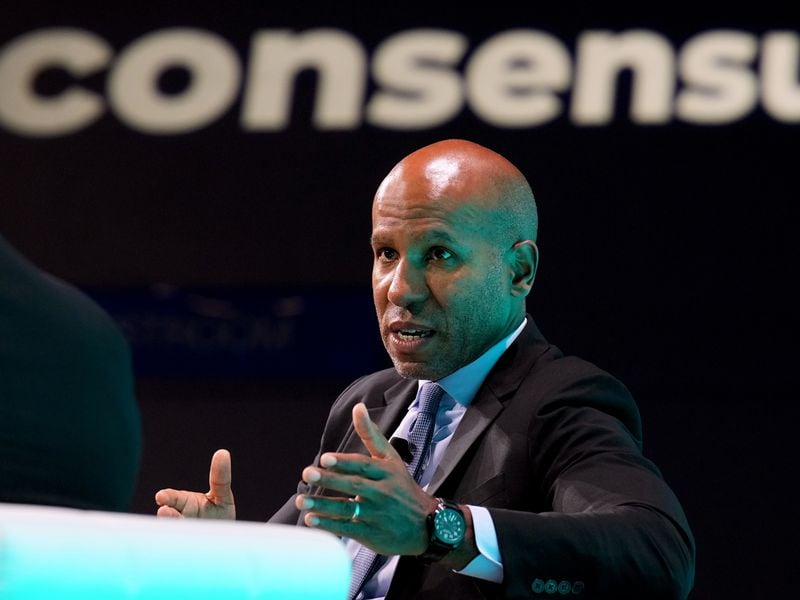MARKETS DAILY: Central Bank Digital Currencies and US Dollar Dominance in 2020
With 2019 vanishing in the rear view mirror, Markets Daily is back for an insightful look into Central Bank Digital Currencies (CBDCs) and the US Dollar’s ongoing reserve status.
Tune in as CoinDesk podcasts editor Adam B. Levine and senior markets reporter Brad Keoun run down recent action, track interesting longer-term trends, and highlight the best “thinking with tokens” and some of the most important crypto industry developments of the day.
No time to listen? Scroll down for the transcript with full links.
Having trouble with the embedded player? You can download the MP3 here.
In this episode:
- Markets, international and industry news roundup
- 2020 looks set to be a big year for Central Bank Digital Currencies (CBDCs), but why? Adam gets into it, with a look at the innovation vs. optimization mindsets
- Another decade of US dollar reserve dominance? Brad’s dug into the numbers and shares his results
More ways to Listen or Subscribe
Transcript
Adam B. Levine: On Today’s episode, bitcoin in the new year, Bahamanian Blockchain Bucks and a look at US Dollar reserve status.
Adam: It’s January 2, 2020, and you’re listening to Markets Daily, I’m Adam B. Levine, editor of Podcasts here At Coindesk, along with our senior markets reporter, Brad Keoun, to give you a concise daily briefing on crypto markets and some of the most important news developments in the sector over the past 24 hours.
Brad: Bitcoin currently around $7100, essentially in the range where it traded through most of the holidays in what was a very calm and quiet end to the year for the largest cryptocurrency, after some pretty wild market swings over the course of the past 12 months
And just to close the books on 2019, bitcoin prices rose $3,475 on the year, recovering roughly a third of the $10,186 decline we saw during 2018, which was so brutal on the entire crypto industry that it’s often referred to as “Crypto Winter”
Bitcoin’s full-year price rise works out to a 94 percent gain on the year, or almost double, in its best year since 2017, when the cryptocurrency’s price famously jumped 13-fold to its all-time-high around $20,000
It’s important to note that as Wall Street celebrated its best full-year performance for stock investors in six years, with the S&P 500 posting a 29% price gain, bitcoin’s performance was roughly triple in size
Adam: Looking out to 2020, it’s going to be a landmark year for crypto development along with a lot of other major world events such as the U.S. presidential election and the quadrennial summer olympics in Tokyo
Perhaps the most high-profile event in the crypto space is bitcoin’s so-called halving, expected in May, when the supply of new units of the cryptocurrency will be cut in half
Some analysts have predicted that the reduction in bitcoin supply, at a time when investor demand for cryptocurrency is increasing, could drive the price to a new all-time high around $100,000
Though other analysts say they think that traders and cryptocurrency miners have already adjusted their price models to reflect anticipated reduction in new bitcoin supply, which means that the impact of the halving should already be theoretically be baked into the market
Brad: Nic Carter of Castle Island Ventures wrote last week in a post on The Block that he thinks that the crypto industry is really just about halfway through a deleveraging from the bubble levels we saw in 2017
He thinks we’ll see further rationalization in the industry in 2020, with some token projects failing to achieve anything resembling critical mass, and dying off, especially in the face of continued regulatory scrutiny
And in yet another setback for a South Korean crypto exchange following last year’s alleged $49 million hack of the Upbit exchange, Bithumb has reportedly had about $70 million worth of taxes on cryptocurrency gains withheld, the first time the country’s tax agency has taken such a step
Bithumb reportedly plans to take legal action against the claim, leaving it unclear what the consequences might be for customers or the exchange itself
A tax professor at the University of Seoul told CoinDesk that the exchange might have to make the tax payment and then go back and try to collect the amount from foreign clients, though from a practical standpoint, that might prove impossible
Adam: Turning to todays featured story, with several proposed central bank digital currencies (CBDCs) picking up steam, CoinDesk’s Danny Nelson reports on one projects quiet holiday launch…
The Bahamas’ digital currency pilot project went live late last month.Residents of the island can now enroll in the Central Bank of The Bahamas’ “Project Sand Dollar,” which began Dec. 27.
They’ll receive mobile wallets the Bahamian government sees as facilitating the future of payments on the island chain. Bankers said “Sand Dollar” is a “digital fiat currency” – not a cryptocurrency, stablecoin or competitor to the Bahamian dollar. Instead, it is simply a digital version “equivalent in every respect to the paper currency,” they said in the project outline.
But it is also a step toward the Bahamas’ long-term goal of launching a fully-fledged central bank digital currency (CBDC), Also called the sand dollar. That larger project would link domestic residents and businesses across a seamless digital payment infrastructure.
CoinDesk.com
Pausing for a moment, we’ll turn to Dr. Gina Pieters, who recently wrote for CoinDesk’s year in review series:
The Central Bank consensus is that decentralization is not a desirable property in a CBDC as it could aid tax avoidance and enable criminal payment systems.
Therefore, while they recognize digital money may be an improvement over physical money, a central bank designed digital currency will not resemble a decentralized cryptocurrency.
Planned CBDCs are not bitcoin-but-issued-by-the-government. They are more like credit-cards-but-issued-by-the-government, where your transactions can be tracked, examined and linked to your taxpayer-identity.
CoinDesk.com
There’s always been two, largely incompatible, ways to appreciate the revolutionary possibilities of cryptocurrency, blockchains and tokens as a way to track ownership as a whole. Call it the difference between innovation and optimization. Innovators like cryptocurrency because its radical trust model eliminates the power which traditional systems imbue in central banks or other forms of monetary policy. They see the current system as fatally flawed by short term human bias, among other things, and decentralized cryptocurrency with its currency issuance publicly known a hundred years in advance, presents what looks like unstoppable competition in a space where competition is simply not allowed, yet is so desperately needed.
The move towards Central Bank Digital Currencies (CBDCs) is the optimization perspective – These people broadly think that current central bank operated money systems are great, but could certainly benefit from improvements… And that’s what they see this technology as, optimizing or improving the rough edges on a system which is already great, and which they have no desire to fundamentally change.
Returning to Danny for more details on the Bahamian program:
In this vision, residents can pay retailers through wallet-linked QR codes, with banks moving funds in digital form. The Central Bank believes this could ultimately cut currency printing costs and transaction fees while enhancing financial inclusion.
“A widely adopted CBDC would place users at less risk of violent crimes that target holders of cash, and potentially reduce security and insurance costs associated with keeping cash on business premises,” according to the outline.
For now, however, the sand dollar faces far more restrictive limits from the government. Businesses cannot hold more than B$1 million in their digital wallets, nor can they transact more than one-eighth of their annual business through the wallets in any given month. And individuals max out at B$500, with higher limits coming through “enhanced due diligence” on their accounts.
CoinDesk.com
Adam: We’ll have more on this developing story as events unfold.
Adam: And now, for today’s spotlight, we’re stepping outside the crypto space to take a look at global foreign exchange markets, and specifically the U.S. dollar’s status as the world’s dominant currency
Brad: The U.S. dollar has been the primary currency for payments in international trade for almost a century, since the world wars of the first half of the 1900s, when the British empire’s influence faded and its currency, pound sterling, saw its use as a global tender decline
Of course the dollar also occupies a key spot in discussion of cryptocurrencies, since the original and oldest digital asset, bitcoin, was originally proposed as a private-market alternative to government-issued currencies like the dollar in peer-to-peer payments
But based on the way that crypto markets have evolved, the dollar is impossible to avoid, since bitcoin is priced in dollars, similar to the way major commodities like oil and gold are quoted in dollars
there’s a growing roster of so-called stablecoins like tether, USD Coin and dai, whose value is pegged to the dollar
And in some ways, even China’s planned digital version of its renminbi might trade a lot like a dollar-linked cryptocurrency, since Chinese authorities typically synch the renminbi’s daily fixed exchange rate with wherever the dollar happens to be trading
Now the big question is how long the dollar can hold on as the global reserve currency
It’s an important question because there are big benefits to the U.S. from having its own currency as such a pillar of global capital markets, but also there’s a self-perpetuating cycle at work here that creates imbalances and the risks of rapid and messy change
U.S. consumers benefit disproportionately from the dollar’s strength, since foreigners are essentially subsidizing Americans’ habit of importing more than they export
And global demand for dollar-denominated assets helps keep interest rates low on things like Treasury bonds despite a U.S. federal budget deficit of more than $1 trillion a year
That dynamic encourages governments, businesses and households to take on ever-growing amounts of debt, which might be difficult to pay back if borrowing costs suddenly jumped
History shows that these epochal shifts do eventually come, but change can be quite slow in coming
And a new report this week from CoinDesk showed that, as China’s global ambitions and rapidly advancing digital-asset technologies pose new threats to the dollar, the U.S. currency looks as strong as ever in global capital markets
As of Dec. 30, an index of the U.S. dollar’s value is up 24 percent over the past decade
That happened even as the Federal Reserve pumped more than $2 trillion of freshly printed money into the financial system and U.S. national debt more than doubled to about $23 trillion – both developments that economists have warned could faster inflation and a reduction in the dollar’s purchasing power
And the greenback’s share of central bank foreign exchange reserves stands at about 62 percent, essentially unchanged since Jan. 1, 2010, according to the International Monetary Fund
The second-place euro, touted by some leading economists in the late 2000s as a potential rival to the dollar, saw its share of central bank reserves decline over the past decade to about 20 percent from 26 percent
The Japanese yen, seen as a threat to the dollar in the 1980s, now accounts for just 5.4 percent of central bank reserves
The British pound, which as we said earlier dominated global trade in the 1800s, has a modest share of 4.4 percent, with its future uncertain as the U.K. moves toward an exit from the European Union
And China, despite decades of rapid economic growth and a push by authorities there to expand the renminbi’s use in international trade and payments, has never seen its currency account for more than 2 percent of central banks’ reserves.
As for digital assets, frequently touted as the future of money, they barely register as an asset class compared with government-issued currencies
Bitcoin’s entire market value stands at about $133 billion, well below central banks’ de minimis $218 billion allocation to the renminbi
The point here is that as the new decade of the 2020s dawn, and we see an array of what appear to be very serious challenges to the dollar’s dominance on the horizon, the dollar is going to be tough to dethrone
And if the dollar were to lose its dominant status, it would entail a pretty landmark and potentially tumultuous shift not just in global capital markets but also in the geopolitical landscape
Adam: Join us again on Friday, for the next Markets Daily from Coindesk. To make sure you never miss an episode, you can subscribe to Markets daily on Apple Podcasts, Spotify, Google Podcasts, and just about any other place you’d like to listen. If you’re enjoying the show, we really appreciate you leaving a review. And if you have any thoughts or comments, email podcasts@coindesk.com
Disclosure Read More
The leader in blockchain news, CoinDesk is a media outlet that strives for the highest journalistic standards and abides by a strict set of editorial policies. CoinDesk is an independent operating subsidiary of Digital Currency Group, which invests in cryptocurrencies and blockchain startups.









